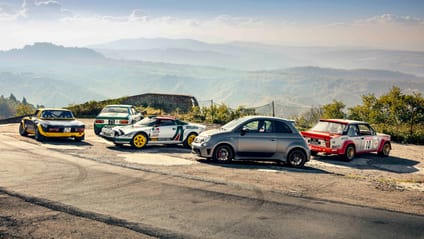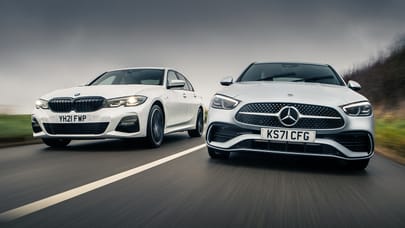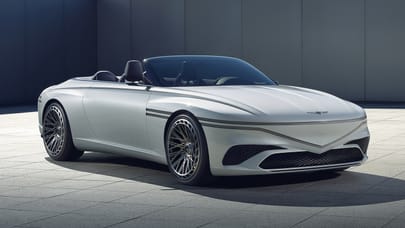
Abarth 695 Biposto across Italy
Biposto meets Fiat 131 Abarth, 124 Spider, Lancia Beta Coupe and Lancia Stratos


Are modern performance cars too easy to drive? The McLaren 675LT and Ferrari F12tdf are two of 2015’s stars, as sexy as Léa Seydoux sashaying down that train carriage in Spectre yet more than happy to serve up 1,436bhp between them without trying to pull your arms off. Assuming you leave all the electronics on, anyway.
Forget them. We are somewhere on the edge of San Marino under a thankfully cloudless autumn sky, we’ve just bounced across our 312th craterous Italian pothole, and I’ve flubbed yet another gearchange, when the realisation hits me that this little Abarth is the trickiest car I’ve driven in a very long time, trickier even than its distant Maranello cousin. Yes, a hopped-up Fiat 500 is bossing me about.
Photography: Joe Windsor-Williams
This feature was originally published in the February 2016 issue of Top Gear magazine.
Advertisement - Page continues below
Except that the Abarth – pronounced ‘A-bart’ – 695 BiPosto is way more than a gussied-up Cinquecento. It’s born of the firm’s single-make Trofeo race series car, reconfigured to work as a road car but, it turns out, only just. Abarth, another one of FCA’s under-appreciated but historically punchy sub-brands, is gearing up for a big product push when the Fiat 124 Spider gets its makeover. If the BiPosto is anything to go by, we certainly like the cut of their jib.
It looks fantastic. The track and wheelarches are pumped up, there’s titanium reinforcement in the rear, and carbon fibre on the sills and front and rear valances. The paint is satin gunmetal. Mechanically, the blown 1.4-litre’s lungs are reworked on the inlet and exhaust side, and there’s a bigger turbo and radiator. That adds up to a juicy 187bhp (at 5,500rpm), and an equally plump £32,990.
But this is footling stuff. Now join me on a journey into the world of BiPosto options, and prepare to suspend your disbelief.

Top of the list is also the reason I’m at war with this Italian hillside. Our car is fitted with a dog ring ’box, a competition-inspired set-up whose helical-cut gears permit brutal clutch-free upshifts provided you time everything to perfection and have £8,500 to drop in the process. That also buys you a mechanical slippy diff, featherweight aluminium flywheel and a gorgeous ally gearlever with an exposed gate. Think of it as a pint-size 458 Speciale – a tender to Ferrari’s warship – and you’re about there.
My hit rate for a satisfactory shift is currently around 50 per cent. Get it right and it’s sublime. Fluff it and it’s like shaking hands with one of those joke-shop comedy buzzers. Ouch. Rather more expensive in the long run, too: this is a genuine competition component, derived from Abarth’s F4 single-seater race programme, and it needs expert attention and an oil change at 12,500 miles. Did I also mention that this particular car has the optional polycarbonate windows, aluminium bonnet, carbon interior and the dashboard data logger, four-point Sabelt harnesses and helmet? Yep, tick all the boxes and this is a £50k 500. Forget the 458, that sort of bread will currently get you a decent used Ferrari 360 Modena.
Advertisement - Page continues below
As we barrel across the Emilian landscape, just about containing the BiPosto’s energy surplus as we bounce from apex to apex, it’s clear that the effort-to-reward ratio is amusingly old-school. The fact is, even on a dry road where the little Abarth is vastly less traction limited than in the wet, its road car-ness is a masquerade. Provincial Italian tarmac is as bad as the crappiest British B-road, and unless I was regularly pummelling Oulton Park, I’d back off the Abarth’s suspension set-up a gnat’s for a bit more civility. (I’m attached to my teeth, and they to me.) No issues with the performance or sound: the BiPosto features an exhaust system by specialist Akrapovič, and pushing the Sport button (a pointless thing on a car like this, surely) releases an extra ululation as well as beefing up the steering. It’ll do 62mph in less than six seconds, but in the real world you’ve got to keep things fizzing or you’ll be undone by turbo lag. It’s also painfully easy to stall, and the clutch’s biting point is horrendous. It’s a demanding wee thing, no doubt about it.

By the time we pull up outside Luca Malatesta’s K Sport facility, I need a rest and fortifying doppia espresso. We’re in the Rimini region, whose hinterland is studded with nondescript industrial estates. Luca’s workshop is equally unprepossessing, but as the shutters roll up my jaw heads south into the floor. Luca’s a former WRC mechanic, and is now one of Italy’s go-to guys for sympathetic maintenance on retired rally warriors. It explains why his place comes over like the automotive equivalent of Qin Shi Huang’s Chinese imperial Terracotta army.
John Hughes, a businessman and former head of the FIA’s historic motorsport commission, has invited TopGear to have a play in some of his rally cars, including a Fiat 131 Abarth, a 124 Spider, a Lancia Beta Coupe, and best of all, an ex-Sandro Munari Lancia Stratos. (There’s also a Lancia 037, the last rear-drive rally hero before the 4WD lunacy of Group B, but it’s currently in pieces.) John isn’t just a lovely man, it also turns out that he worked for F1 outfit RAM Racing back in the era of pre-qualifying and upwards of 30-car grids, where his timekeeping duties earned him the nickname ‘Clock’. RAM ran the likes of Alan Jones, Guy Edwards and Kenny Acheson, and John also got close to future power brokers Max Mosley and Bernie Ecclestone. “Derek Daly once drove a rental car into the lobby of our hotel and did laps of the fountain,” he recalls. “It really was a different era.”

As it was in world rallying. Now a sadly diminished spectacle, it’s easy to forget that for much of the Seventies and Eighties the WRC rivalled Formula One for prestige and global pull. And heroes. If you go down this particular internet rabbit hole, prepare to waste hours marvelling at some of the noisiest competition machinery ever made, and drivers with surreal levels of skill. As Luca’s guys warm up his cars, plumes of exhaust fumes billowing across us, John dissects this very particular passion. “It’s reliving your youth, living those great rallies vicariously,” he says. “To own one of these cars really is a dream. Historic motorsport is expensive, but compared to modern motorsport it’s not too bad.
"And if you buy the right car it’s probably going to appreciate. The cars also looked very different from each other. They have massive character. The Stratos is Boy’s Own, poster-on-the-wall stuff, partly because it has a reputation for being tricky. It is – I can confirm that.”

Me too. This is the third one I’ve driven, and just getting into it is an anatomical feat. Then there’s the driving position itself, which places you pretty much in the centre of the car, the visor-like windscreen, and the bulging doorbins designed to accommodate helmets and maps. You don’t sit in the Stratos, or even on it, and you don’t wear it like you do some cars: you come to an uneasy arrangement with it. And that’s before you even start it up.
Of course, it sounds Godlike. First gear is on a dog-leg, and the ’box needs an odd mix of finesse and brute force. Even on a brief foray on local roads, the Stratos feels at once like a car that would cheerfully kill you while being completely intoxicating at the same time. Few engines sound as sonorous as the Ferrari-sourced 2.4-litre V6 that sits high in the middle of the treacherously stumpy Stratos – the name is thought to be an abbreviation of stratosphere – and even a modest 280bhp (for a car with the 12-valve head, 320-plus in the 24-valve car) is enough to give you palpitations.
Advertisement - Page continues below
John’s is a fabulously authentic Group 4 car, with the original braking system, Bilstein shocks, welded rear top mounts, and 48mm carbs and twin throttle cables, among a long list of mostly now impossible-to-find parts. Back in 1974, a car almost identical to this won by a (cross-) country mile on its debut in the San Remo rally, and went on to win the championship that year, and again in ’75 and ’76. For motorsport fans of an increasingly wrinkly vintage, Munari, Waldegaard and Darniche are names to conjure with. How did they do it? By having unfeasibly sizeable cojones.
Darniche was driving when the Stratos scored its last rally victory, on 1981’s Tour de Corse. By this time, the Fiat Group had transferred its factory muscle to the 131 Abarth, based on the firm’s mid-Seventies saloon, and a car even Fiat ultra-geeks have consigned to the margins. But not me, because as a bestubbled Latin Escort it was infinitely cooler as it sprayed gravel all over the show while apparently spending its life permanently sideways. Bertone did the assembly work on the car, Abarth the preparation, learning things across a frankly bewildering array of prototypes, including a rally version of the mid-engined X1/9 and supercharged iterations.

It meant they were in good shape by 1977, when the 131 embarked on a career that would net world championships that year, and again in ’78 and ’80. This particular example is the definitive works car, its cubist silhouette even more square-rigged thanks to its enlarged wheelarches and wider track, the front end enlivened by the Fiat Abarth decal on the grille and outsized auxiliary lamps. Even the old-style numberplates stoke the fires of romance.
It’s powered by a 215bhp, 2.0-litre twin-cam 16v, with mechanical Kugelfischer fuel injection, and runs a close-ratio five-speed dog ’box: more gearchanging trauma beckons. OK, so it’s far less glamorous-looking than its Stratos forebear, but the 131 Abarth is immediately addictive, for two important reasons. Firstly, it only weighs around a tonne (depending on spec – gravel cars were a little heavier) and its lack of mass is obvious the moment you touch anything inside; somehow it feels fragile yet completely bulletproof at the same time. Run your eyes across the dials and you’ll spot the second big win – the yellow adhesive sliver on the rev counter that tells you the 131 is redlined at 8,600rpm…
Advertisement - Page continues below
Following the unbelievably noisy 124 Spider down the hill to Luca’s base – it was a recce car in a former life and one of a scant few left that’s completely original – the 131 Abarth is nothing less than the best-sounding four-cylinder car I’ve ever driven. When it comes on cam at 3,500rpm, even these mighty hills are forced to play second fiddle. Forget Italy’s supercar heritage, this boxy old Fiat saloon is from an era when this fabulous country knew how to wring soul out of machines.
If nothing else, it’s a trick the Abarth BiPosto – for all its flaws – manages to pull 40 years later.
Trending this week
- Electric
Top Gear's top 20 electric cars









